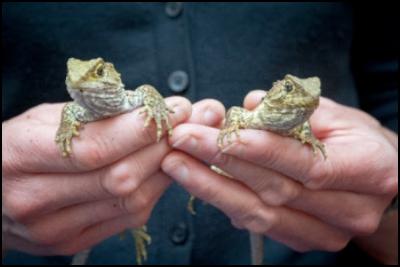Juvenile tuatara to come of age at Zealandia
Juvenile tuatara to come of age at Zealandia

It's Tuatara February at Zealandia. To celebrate, five juvenile tuatara will be released into the sanctuary this Thursday when they are returned from Victoria University of Wellington’s captive incubation programme.
“In the wild, eggs hatch after 12 – 15 months and hatchlings will often emerge when the next season’s eggs are being laid,” explained Zealandia Conservation Manager, Raewyn Empson.
“We found some of these eggs exposed and they were taken, along with the others in the clutch, to Victoria University of Wellington for incubation.”
Tuatara are a threatened species that have been extinct from the mainland since the late 1700’s. They were first introduced to Zealandia in 2005 and became the first breeding population on the mainland in over 200 years. The sanctuary now supports a population of over 200 individuals.
“Tuatara have a slow reproductive cycle and females do not breed every year, so it will take many decades for tuatara to fully populate Zealandia,” explained Susan Keall, Senior Technical Officer at Victoria University of Wellington.
“As we have the equipment and experience here at Victoria to successfully incubate eggs, we can assist the population growth by incubating and hatching eggs that would have otherwise failed.”
The tuatara will be released in the main sanctuary, outside a fenced off research area where the eggs were originally found.
“By releasing them outside the fenced area where they were found, we hope to increase genetic diversity in the population. It also means visitors will have a better chance to see juveniles in the main sanctuary, where they are usually more spread out. We have seen wild juveniles outside the fenced area and are confident these five will survive,” explained Empson.
Zealandia has been celebrating tuatara all month during Tuatara February. This release will allow visitors to see conservation in action before exploring the sanctuary until it closes at 7.30pm.
It is hoped that Tuatara February will increase awareness about tuatara conservation and research in the sanctuary to contribute to their ongoing survival as a species.
The public is invited to join Tuatara February celebrations all month by attending the release this evening at 6pm. It is suggested that they arrive at 5.30pm to allow for walking time to reach the release site.
FACTS:
• Tuatara are a rare
reptile found only in New Zealand.
• Tuatara were
extinct from the mainland since the late 1700’s until they
were released at Zealandia in 2005.
Why are tuatara
important?
• Tuatara are the only living member of
the Rhynchocephalia order. Their ancestors were well
represented by many species during the age of the dinosaurs.
This makes them important in understanding reptile
evolution.
• Tuatara reproduction is affected by temperature. The temperature that eggs experience during incubation will determine the sex of the hatchlings. Scientists suspect that global warming could cause the extinction of tuatara. Once a population has more males than females, not enough young can be produced to replace old animals.
ends


 Yachting New Zealand: Project Arotake Update - Oversight Group Formed As Top Names Appointed To High-Performance Advisory, ALG
Yachting New Zealand: Project Arotake Update - Oversight Group Formed As Top Names Appointed To High-Performance Advisory, ALG Hospice NZ: Sustainable Funding For Hospices
Hospice NZ: Sustainable Funding For Hospices David Hill - LDR: Surge In Young Parents’ College Enrolments
David Hill - LDR: Surge In Young Parents’ College Enrolments NZEI Te Riu Roa: School Lunches - Give Schools Option To Use In-School And Community Providers Immediately, Union Says
NZEI Te Riu Roa: School Lunches - Give Schools Option To Use In-School And Community Providers Immediately, Union Says University of Auckland: Billion-dollar Business Lessons From Kiwi Entrepreneur
University of Auckland: Billion-dollar Business Lessons From Kiwi Entrepreneur NZ Veterinary Association: NZVA Celebrates Welcome Additional Support From Veterinary Nurses
NZ Veterinary Association: NZVA Celebrates Welcome Additional Support From Veterinary Nurses